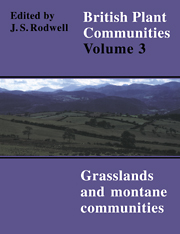Book contents
- Frontmatter
- Contents
- List of Figures
- Preface and Acknowledgements
- Preamble
- Mesotrophic Grasslands
- Community Descriptions
- Calcicolous Grasslands
- Community Descriptions
- Calcifugous Grasslands and Montane Communities
- Community Descriptions
- Index of Synonyms to Grasslands and Montane Communities
- Index of Species in Grasslands and Montane Communities
- Bibliography
MG3 - Anthoxanthum Odoratum-Geranium Sylvaticum Grassland
Published online by Cambridge University Press: 04 July 2020
- Frontmatter
- Contents
- List of Figures
- Preface and Acknowledgements
- Preamble
- Mesotrophic Grasslands
- Community Descriptions
- Calcicolous Grasslands
- Community Descriptions
- Calcifugous Grasslands and Montane Communities
- Community Descriptions
- Index of Synonyms to Grasslands and Montane Communities
- Index of Species in Grasslands and Montane Communities
- Bibliography
Summary
Synonymy
Trisetetum flavescentis Beger 1922; Hay meadows Pigott 1956a, Bradshaw 1962, Bradshaw & Clark 1965, Ratcliffe 1978; Dales hay meadows Duffey et al. 1974; Northern hay meadows Ratcliffe 1977; Helictotricho-Trisetetum Jones 1984 p.p.; Dactylo-Geranietum Jones 1984.
Constant species
Agrostis capillaris, Alchemilla glabra, Anthoxanthum odoratum, Cerastium fontanum, Conopodium majus, Dactylis glomerata, Festuca rubra, Geranium sylvaticum, Holcus lanatus, Plantago lanceolata, Poa trivialis, Ranunculus acris, Rumex acetosa, Sanguisorba officinalis, Trifolium repens.
Rare species
Alchemilla acutiloba, A. glomerulans, A. monticola, A. subcrenata, A. wichurae.
Physiognomy
The Anthoxanthum odoratum-Geranium sylvaticum community has a dense growth of grasses and herbaceous dicotyledons up to 60-80 cm high. Among the former, Anthoxanthum odoratum, Dactylis glomerata, Festuca rubra, Holcus lanatus, Agrostis capillaris and Poa trivialis are constant with Cynosurus cristatus, Trisetum flavescens, Poapratensis, Alopecuruspratensis and Festuca pratensis occurring throughout though less frequently. Some of these grasses may attain local abundance (especially the constant species) and there is also some phenological variation with fine-leaved species such as F. rubra, P. trivialis and A. odoratum prominent early in the season but later being overtopped by the more tussocky coarse-leaved species such as H. lanatus and D. glomerata. However, it is a feature of the community that no single grass species is consistently dominant. Indeed, grasses as a whole commonly comprise a relatively small proportion of the herbage and the most obvious physiognomic feature of the vegetation is generally the variety and abundance of dicotyledons. In summer, the vegetation presents a colourful spectacle and has earned itself the local name of ‘herbie meadow’.
Among the constant dicotyledons, Geranium sylvaticum is usually the most prominent and exceptionally may account for 90% of the cover. Sanguisorba officinalis, Conopodium majus, Alchemilla glabra and A. xanthochlora are also occasionally abundant and by the end of June these five species generally comprise the bulk of the herbage. Beneath, Plantago lanceolata, Rumex acetosa, Ranunculus acris, Cerastium fontanum and Trifolium repens are constant components with Taraxacum officinale agg., Lathyrus pratensis, Bellis perennis and Ranunculus bulbosus frequent. Tall herbs are generally uncommon, although Heracleum sphondylium is occasionally conspicuous. Among the low-frequency associates are Cardamine pratensis, Anemone nemorosa, Cirsium helenioides, Trollius europaeus, Leucanthemum vulgare, Euphrasia montana, Polygonum viviparum, Trifolium medium, Dactylorhiza fuchsii, Coeloglossum viride, Orchis mascula, Gymnadenia conopsea, Leucorchis albida and Listera ovata. Three ancient introductions, Rumex longifolius, Polygonum bistorta and Peucedanum ostruthium occur locally, sometimes in dense patches.
- Type
- Chapter
- Information
- British Plant Communities , pp. 49 - 55Publisher: Cambridge University PressPrint publication year: 1992



